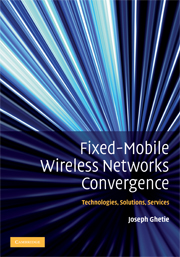Book contents
- Frontmatter
- Contents
- Disclaimer
- How the Book is Organized
- List of Figures
- List of Tables
- Preface
- Acknowledgments
- Acronyms
- Part I Wireless Communications: Networking and Management
- 1 Wireless Communications and Networking
- 2 Network Management
- 3 Service Management
- Part II Cellular Mobile Radio Networking and Management
- Part III Fixed Wireless Technologies: Networking and Management
- Part IV Fixed Wireless Cellular Mobile Networks Convergence and Integration
- Part V Fixed Wireless Cellular Mobile Networks Convergence: Standardized Networking Solutions
- Part VI Fixed-Mobile Convergence Services, Industry Trends, and Implementation Issues
- References
- Index
3 - Service Management
from Part I - Wireless Communications: Networking and Management
Published online by Cambridge University Press: 21 August 2009
- Frontmatter
- Contents
- Disclaimer
- How the Book is Organized
- List of Figures
- List of Tables
- Preface
- Acknowledgments
- Acronyms
- Part I Wireless Communications: Networking and Management
- 1 Wireless Communications and Networking
- 2 Network Management
- 3 Service Management
- Part II Cellular Mobile Radio Networking and Management
- Part III Fixed Wireless Technologies: Networking and Management
- Part IV Fixed Wireless Cellular Mobile Networks Convergence and Integration
- Part V Fixed Wireless Cellular Mobile Networks Convergence: Standardized Networking Solutions
- Part VI Fixed-Mobile Convergence Services, Industry Trends, and Implementation Issues
- References
- Index
Summary
Service Management Conceptual Model
In general terms, the notion of service is an abstraction. However, in an actual context such as communication service, it becomes more meaningful. If we add service qualifiers such as availability, speed, security, integrity, and responsiveness, we have something palpable to the user. The ultimate goal of any service is to satisfy the customer. That means services that assure the good functioning of a network, system, processes, and overall business in a cost-effective way. Service Management is an area of management that was designed specifically to address these issues. Service Level Management (SLM) is that part of management that encompasses networks and systems, binding together service providers with users of services. It does this by identifying, defining, tracking, and even proactively monitoring the services.
Communication services are provided on a contractual basis between customers (organizations, businesses, or individual subscribers) and one or multiple service providers. These services are to be delivered with the assurances that the exchange of information on data communication networks will be done under well-defined conditions and with guaranteed performance. A simplified communications service conceptual model is presented in Figure 3.1. Service providers with adequate applications and network infrastructure provide communication service to customer systems. Multiple service providers are usually involved in providing communications services because of the particular media used (wireless, fiber optic, cable, twisted pair), the type of network (access, connectivity, backbone), the type of information (voice, data, video, multimedia), and the communications technologies adopted.
Information
- Type
- Chapter
- Information
- Fixed-Mobile Wireless Networks ConvergenceTechnologies, Solutions, Services, pp. 47 - 60Publisher: Cambridge University PressPrint publication year: 2008
